
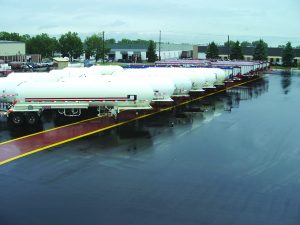
Coloured asphalt has many applications.
There have been many innovations in asphalt pavement and road surface technology over the past few years. While some of these innovations have been embraced by municipalities and private companies, others have fared poorly when faced with the reality of Canadian winters.
One of the most visible developments has been the increasing use of coloured asphalt. The Regional Municipality of York, located north of Toronto, uses red asphalt to mark dedicated lanes for its rapid transit bus system on some of its busiest roadways. Ottawa also uses coloured bus lanes while Edmonton employs green asphalt to identify its bicycle lanes.
In each instance, enhancing public safety is the goal. Red asphalt mix in particular increases the visibility of bus routes to oncoming traffic.
“The black lane is for regular traffic. [Car and truck drivers] keep off the red lanes because those are for buses,” explains Ludomir Uzarowski, P. Eng., and Principal for Pavement and Materials Engineering at Mississauga, Ont.-based Golder Associates Ltd.
The drawback? Coloured asphalt isn’t cheap.
“Clear binders and proper colouring agents can become cost prohibitive,” says Matt Grimm, Director of Construction and Asphalt for Western Canada at Lafarge.
Keeping cool
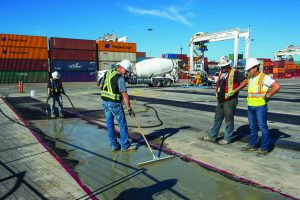
A DuraTough application.
Light coloured asphalt is another growing trend. Newly laid black asphalt pavement has an SRI (Solar Reflectance Index) value of zero, meaning it doesn’t reflect solar heat very well, so gets very hot. By contrast, light coloured asphalt not only has a higher SRI to stay cooler, but it lasts longer, is more durable and crack-resistant than traditional asphalt and has superior frictional characteristics. Pale-hued asphalt also helps contractors achieve a LEED credit for construction projects in which 50 per cent or more of hardscape has a minimum SRI value of 29.
On the downside, techniques to lighten the colour of asphalt — such as using colourless or reflective synthetic binders or applying coatings to an asphalt surface — are costly.
Manufacturing and maintaining asphalt in an eco-friendly fashion is becoming more common, as evidenced by the popularity of recycling methods such as Full Depth Reclamation (FDR).
Grimm says FDR has been used extensively in Western Canada, particularly in Edmonton where cement stabilization of the treated base deteriorates over time, resulting in reflective cracking that weakens the paved surface. “This construction practice has been introduced into paving contracts by Alberta Transportation and has been used on many projects over the last three years. Some projects have been introduced into the City of Calgary as well,” he says.
“The performance of the recycled pavements has been good to very good. The sustainability benefits of the green technologies in the Region in terms of economic, environmental, and social aspects have been tremendous,” concluded a paper Uzarowski co-wrote for the 2014 Annual Conference of the Transportation Association of Canada that examined decades-old pavement recycling programs in the Region of Waterloo, in Southern Ontario.
Some companies have taken an eco-friendly approach to making asphalt. Lafarge has a product called Duraclime which is created through a warm mix, reduced-temperature process. The product employs large amounts of reclaimed asphalt pavement and asphalt shingle modifier. The manufacturing process reduces fuel consumption, emissions, smell and smoke. Other companies, such as Colas Solutions, offer a plant-based asphalt mix called Vegecol.
Good business sense
An eco-friendly approach makes good business sense given the advent of “carbon credits and the carbon economy,” notes Grimm.
In another trend, Superpave (a performance-related asphalt binder and mixture specification) is being rapidly adopted in many areas.
Hugh B. Donovan, P. Eng., and Manager of Operations for Edmonton’s Engineering Services Quality Assurance Laboratory, a road surface research facility, says that many Canadian jurisdictions have switched to Superpave. “Not as many municipal jurisdictions but certainly some of the highways in Ontario have it,” he says. Quebec uses it, and Edmonton switched to Superpave around two years ago, Donovan adds.
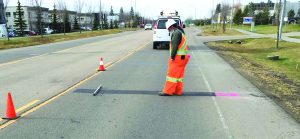
Monitoring potholes.
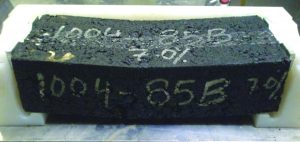
Beam fatigue testing.
The lab’s purpose is to evaluate various pothole filling materials and seek ways to improve the city’s asphalt mixes so pavement lasts longer.
Also popular currently is the use of fiber in hot-mix asphalt mixes, which is generating interest from some municipalities and airports, Uzarowski says. “We believe it may have significant potential for some improvement in hot asphalt mix performance.”
ACE fiber and Forta Asphalt Fiber, are two examples of fiber manufacturers. They claim that their products have great benefits to asphalt, including: increased resistance to reflective cracking, fatigue and rutting; and boosting life expectancy.
Grimm has seen a couple of recent trends developing in road surface technology, chiefly, the use of fine graded surface mixes (and lowering the top size of the aggregate) to produce a tighter road surface.
“A tighter road surface prevents the egress of air and water into the pavement (and) that promotes a longer lasting, more durable pavement.”
Longer lasting and more durable
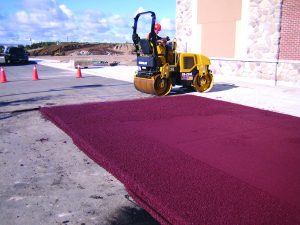
A DuraTint application.
“A tighter road surface prevents the egress of air and water into the pavement (and) that promotes a longer lasting, more durable pavement,” he explains.
Grimm also notes that the use of anti-strip additives to reduce moisture damage to the pavement is on the upswing.
Of course, not every road surface innovation fits the Canadian market.
“We looked at porous asphalt but unfortunately in our environment, those asphalts don’t tend to work very well because of our freeze-thaw cycle and the fact we put [sand and salt] on our roads in wintertime,” says Donovan. He says when using porous type asphalts or concretes, the voids get plugged up pretty quickly.
Noise reducing asphalt has faced similar challenges. Lafarge has a product called Durawhisper, which blends crumb rubber and a polymer modified binder to create an asphalt overlay that improves rutting resistance and reduces traffic noise by up to eight decibels.
“One of the first trials we did was in the City of Nanaimo [British Columbia]. Not only did it reduce noise, it reduced spray in wet conditions. You got a lot less spray coming off tires onto windshields,” says Grimm.
Avoid colder climates
However, results weren’t as positive in colder climates: “The issue with any of the open-graded mixes like Durawhisper is that in wintertime, with winter sanding, you eventually get those voids filled with sand or salt,” he says. So for Canada, it works for the West Coast, but has limited applications in colder regions.
A new product from Lafarge called Duratough is a surfacing system for pavement that experiences slow or heavy traffic or where a tough, impermeable surface layer is required.
Looking forward, expect to see more emphasis on road surface smoothness.
“Governments are starting to realize smoothness is becoming more and more of a key driver to the quality of the [roads]. The smoother the road, the longer you can operate,” says Grimm.
Industry experts say road surface technology will continue to progress as needs change and evolve.
“Our industry has been and continues to be innovative. These different technologies form part of our extensive toolbox to meet the needs of the owner, to help build long lasting, durable roads,” says Vince Aurilio, Executive Director of the Ontario Asphalt Pavement Council (OAPC).




